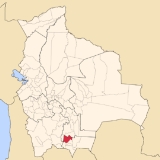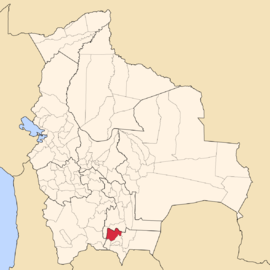
Eustaquio Méndez Province
Encyclopedia
| Location in Bolivia | |
|---|---|
 |
|
| Main Data | |
| Capital | San Lorenzo San Lorenzo, Tarija San Lorenzo is a town in the Tarija Department in Bolivia.-Location:San Lorenzo is the administrative center of Eustaquio Méndez Province and situated at , 2,001 m above sea leavel, on the left bank of Río Tojtiwaysho, 15 km north of Tarija, the department capital.-Population:San Lorenzo had a... |
| Area Area Area is a quantity that expresses the extent of a two-dimensional surface or shape in the plane. Area can be understood as the amount of material with a given thickness that would be necessary to fashion a model of the shape, or the amount of paint necessary to cover the surface with a single coat... |
4,070 km² |
| Population Population A population is all the organisms that both belong to the same group or species and live in the same geographical area. The area that is used to define a sexual population is such that inter-breeding is possible between any pair within the area and more probable than cross-breeding with individuals... |
32,038 (2001) |
| Density Density The mass density or density of a material is defined as its mass per unit volume. The symbol most often used for density is ρ . In some cases , density is also defined as its weight per unit volume; although, this quantity is more properly called specific weight... |
7.9 inhabitants/km² (2001) |
| ISO 3166-2 ISO 3166-2 ISO 3166-2 is part of the ISO 3166 standard published by the International Organization for Standardization , and defines codes for the names of the principal subdivisions of all countries coded in ISO 3166-1... |
BO.TR.MD |
Eustaquio Méndez is a province
Province
A province is a territorial unit, almost always an administrative division, within a country or state.-Etymology:The English word "province" is attested since about 1330 and derives from the 13th-century Old French "province," which itself comes from the Latin word "provincia," which referred to...
in the north-western parts of the Bolivia
Bolivia
Bolivia officially known as Plurinational State of Bolivia , is a landlocked country in central South America. It is the poorest country in South America...
n department
Departments of Bolivia
Bolivia is divided into nine departments . Each of the departments is subdivided into provinces , which are further subdivided into municipalities ....
Tarija
Tarija Department
Tarija is a department in Bolivia. It is located in south-eastern Bolivia bordering Argentina to the south and Paraguay to the east. According to the 2001 census, it has a population of 391,226 inhabitants. It has an area of 37.623 km²...
.
Location
Eustaquio Méndez province is one of six provinces in the Tarija Department. It is located between 20° 57' and 21° 36' southLatitude
In geography, the latitude of a location on the Earth is the angular distance of that location south or north of the Equator. The latitude is an angle, and is usually measured in degrees . The equator has a latitude of 0°, the North pole has a latitude of 90° north , and the South pole has a...
and between 64° 23' and 65° 15' west
Longitude
Longitude is a geographic coordinate that specifies the east-west position of a point on the Earth's surface. It is an angular measurement, usually expressed in degrees, minutes and seconds, and denoted by the Greek letter lambda ....
.
The province borders Chuquisaca Department
Chuquisaca Department
Chuquisaca is a department of Bolivia located in the center south. It borders on the departments of Cochabamba, Tarija, Potosí, and Santa Cruz. The departmental capital is Sucre, which is also the constitutional capital of Bolivia.-Geography:...
in the north and west, José María Avilés Province
José María Avilés Province
José María Avilés is a province in the western parts of the Bolivian department Tarija.-Location:Avilés province is one of six provinces in the Tarija Department...
in the south, Cercado Province
Cercado Province (Tarija)
Cercado is a province in the central parts of the Bolivian department Tarija.-Location:Cercado province is one of six provinces in the Tarija Department...
in the south-east, and Burnet O'Connor Province
Burnet O'Connor Province
Burnet O'Connor is a province in the northern part of Tarija Department in Bolivia.The province is also known as Burdet O'Connor and is named after Francisco Burdett O'Connor, a chronicler of the South American War of Independence and the making of Tarija.-Location:Burnet O'Connor province is one...
in the east.
The province extends over 90 km from north to south, and 105 km from east to west.
Population
The principal languageLanguage
Language may refer either to the specifically human capacity for acquiring and using complex systems of communication, or to a specific instance of such a system of complex communication...
of the province is Spanish
Spanish language
Spanish , also known as Castilian , is a Romance language in the Ibero-Romance group that evolved from several languages and dialects in central-northern Iberia around the 9th century and gradually spread with the expansion of the Kingdom of Castile into central and southern Iberia during the...
, spoken by 99.7 %, while 1.7 % of the population speak Quechua, 0.2 speak Aymara
Aymara language
Aymara is an Aymaran language spoken by the Aymara people of the Andes. It is one of only a handful of Native American languages with over three million speakers. Aymara, along with Quechua and Spanish, is an official language of Peru and Bolivia...
, and 0.1 % Guaraní
Guaraní language
Guaraní, specifically the primary variety known as Paraguayan Guaraní , is an indigenous language of South America that belongs to the Tupí–Guaraní subfamily of the Tupian languages. It is one of the official languages of Paraguay , where it is spoken by the majority of the population, and half of...
.
The population increased from 29,868 inhabitants (1992 census
Census
A census is the procedure of systematically acquiring and recording information about the members of a given population. It is a regularly occurring and official count of a particular population. The term is used mostly in connection with national population and housing censuses; other common...
) to 32,038 (2001 census), an increase of 7.3 %. - 46.9 % of the population are younger than 15 years old.
78.1 % of the population have no access to electricity
Electricity generation
Electricity generation is the process of generating electric energy from other forms of energy.The fundamental principles of electricity generation were discovered during the 1820s and early 1830s by the British scientist Michael Faraday...
, 77.8 % have no sanitary facilities
Tap water
Tap water is a principal component of "indoor plumbing", which became available in urban areas of the developed world during the last quarter of the 19th century, and common during the mid-20th century...
(1992).
67.8 % of the population are employed in agriculture
Primary sector of industry
The sector of an economy making direct use of natural resources. This includes agriculture, forestry and fishing, mining, and extraction of oil and gas. This is contrasted with the secondary sector, producing manufactures and other processed goods, and the tertiary sector, producing services...
, 0.1 % in mining
Mining
Mining is the extraction of valuable minerals or other geological materials from the earth, from an ore body, vein or seam. The term also includes the removal of soil. Materials recovered by mining include base metals, precious metals, iron, uranium, coal, diamonds, limestone, oil shale, rock...
, 5.9 % in industry
Secondary sector of industry
The secondary sector of the economy or industrial sector includes those economic sectors that create a finished, tangible product: production and construction.-Function:...
, 26.2 % in general services
Tertiary sector of industry
The tertiary sector of the economy is one of the three economic sectors, the others being the secondary sector and the primary sector .The service sector consists of the "soft" parts of the economy, i.e...
(2001).
95.1 % of the population are Catholics
Roman Catholicism in Bolivia
The Roman Catholic Church in Bolivia is part of the worldwide Roman Catholic Church, under the spiritual leadership of the Pope and curia in Rome....
, 3.1 % are Protestants
Iglesia Anglicana del Cono Sur de las Americas
The Anglican Church of the Southern Cone of America is the ecclesiastical province of the Anglican Communion that covers the countries of Argentina, Bolivia, Chile, Paraguay, Peru and Uruguay....
(1992).
Division
The province comprises two municipalitiesMunicipalities of Bolivia
Municipalities in Bolivia are administrative divisions of the entire national territory governed by local elections. Municipalities are the third level of administrative divisions, below departments and provinces. Some of the provinces consist of only one municipality...
:
- El Puente Municipality
- San Lorenzo Municipality

